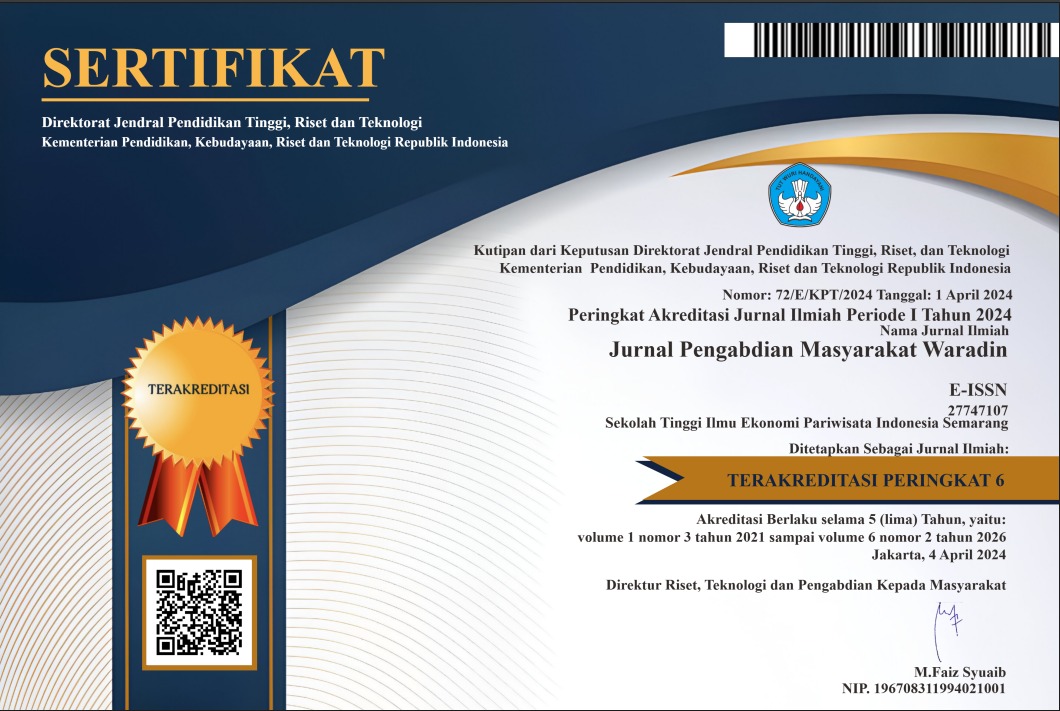Edukasi Deteksi Pencegahan Kanker Leher Rahim Melalui Vaksinasi HPV di SMAN 8 Kota Pekanbaru
DOI:
https://doi.org/10.56910/wrd.v4i2.588Keywords:
Cervix Cancer, HPV immunization, Health EducationAbstract
Cervical Cancer (Cervical Cancer) is a malignant tumor that grows in the cervix (the lowest part of the uterus that attaches to the top of the vagina. Cervical cancer usually attacks women aged 35-55 years. 90% of cervical cancer comes from squamous cells that lining the cervix and the remaining 10% comes from mucus-producing gland cells in the cervical canal that leads to the uterus. The aim of this activity is to prevent cervical cancer by providing outreach or education about The importance of HPV (Human Papilloma Virus) immunization in preventing the occurrence of cervical cancer so that preventive measures can be carried out as early as possible, so that it can reduce the incidence of cervical cancer. The result of this activity is to prevent the occurrence of cervical cancer Early prevention by carrying out HPV immunization
References
Andrews, G. (2010). Buku Ajar Kesehatan Reproduksi Wanita. Jakarta: EGC.
Bray, F., Ferlay, J., Soerjomataram, I., Siegel, R. L., Torre, L. A., & Jemal, A. (2018). Global cancer statistics 2018: GLOBOCAN estimates of incidence and mortality worldwide for 36 cancers in 185 countries. CA: A Cancer Journal for Clinicians, 68(6), 394–424. https://doi.org/10.3322/caac.21492
Ganchimeg, T., Mori, R., & Shibuya, K. (2017). Factors affecting HPV vaccination among adolescents in Asia: A systematic review. Asian Pacific Journal of Cancer Prevention, 18(5), 1343–1349. https://doi.org/10.22034/APJCP.2017.18.5.1343
Garland, S. M., Tabrizi, S. N., & Hiller, P. (2007). Prevention of cervical cancer through vaccination. The Lancet, 369(9574), 1696–1705. https://doi.org/10.1016/S0140-6736(07)60629-4
Harro, C. D., et al. (2001). Safety, immunogenicity, and efficacy of a bivalent L1 virus-like particle vaccine against human papillomavirus types 16 and 18 in women aged 15–25 years. Journal of Clinical Oncology, 19(3), 2151–2162. https://doi.org/10.1200/JCO.2001.19.3.2151
Hartono, P. (2000). Kanker Serviks & Masalah Skrinning di Indonesia. Kursus pada Pra Kongres KOGI I & Pasar Mimbar, 5(2).
Irawati. (2011). Pengetahuan Dan Sumber Informasi Kesehatan Reproduksi Remaja Di Indonesia. Vol 1 No 2.
Kementerian Kesehatan Republik Indonesia. (2011). Modul Pelatihan Pelayanan Kesehatan Peduli Remaja (PKPR) Bagi Tenaga Kesehatan. Jakarta: Kementerian Kesehatan RI.
Kementerian Kesehatan Republik Indonesia. (2016). Pedoman imunisasi HPV untuk remaja putri. Jakarta: Kementerian Kesehatan RI.
Sankaranarayanan, R., et al. (2010). Early detection of cervical cancer with visual inspection and HPV testing. The Lancet, 368(9534), 118–119. https://doi.org/10.1016/S0140-6736(06)69358-2
Tabrizi, S. N., et al. (2012). Vaccine effectiveness against cervical HPV types 16 and 18 in women aged 15–26 years. Vaccine, 30(2), 290–298. https://doi.org/10.1016/j.vaccine.2011.11.026
Turok, D. K., et al. (2015). HPV vaccine education in schools: A model for reaching young women. Journal of Adolescent Health, 56(3), 334–339. https://doi.org/10.1016/j.jadohealth.2014.10.277
Wiknjosastro. (2009). Ilmu Kebidanan. Jakarta: Yayasan Bina Pustaka Sarwono Prawirohardjo.
World Health Organization (WHO). (2020). Human papillomavirus (HPV) and cervical cancer. Retrieved from https://www.who.int/news-room/fact-sheets/detail/human-papillomavirus-(hpv)-and-cervical-cancer







